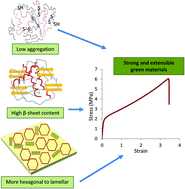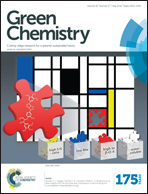The use of plants as a “green factory” to produce high strength gluten-based materials†
Abstract
The aim of the present study was to develop an understanding of how wheat plants can be used as a “green factory” by the modulation of genotype (G) and environmental (E) interactions to fine-tune the structure and increase the strength of gluten based materials. Two wheat genotypes (5 + 10 and 2 + 12) were grown under four nitrogen and two temperature regimes to obtain gluten of various characteristics. Protein microstructure morphology revealed by confocal laser scanning microscopy suggested a higher polymerisation of proteins in glycerol plasticized films from the 5 + 10 compared to the 2 + 12 genotype. Also, films with the highest Young's modulus and maximum stress were obtained from the 5 + 10 genotype, which might be explained by the higher number of cysteine residues and consequently more disulphide crosslinks in this genotype compared to the 2 + 12 one. The presence of two nano-scaled morphologies, hexagonal and lamellar structures and their internal relations were found to be of relevance for formation of β-sheets and also to be related to performance (strength) of the material. Thus, plants could be used as a “green factory”, avoiding the use of chemicals, to tune the tensile properties of the materials. Structural properties such as relatively low protein aggregation, high β-sheet content and a high hexagonal to lamellar structural ratio at the nano-scale were found to yield films with high stiffness and strength.


 Please wait while we load your content...
Please wait while we load your content...